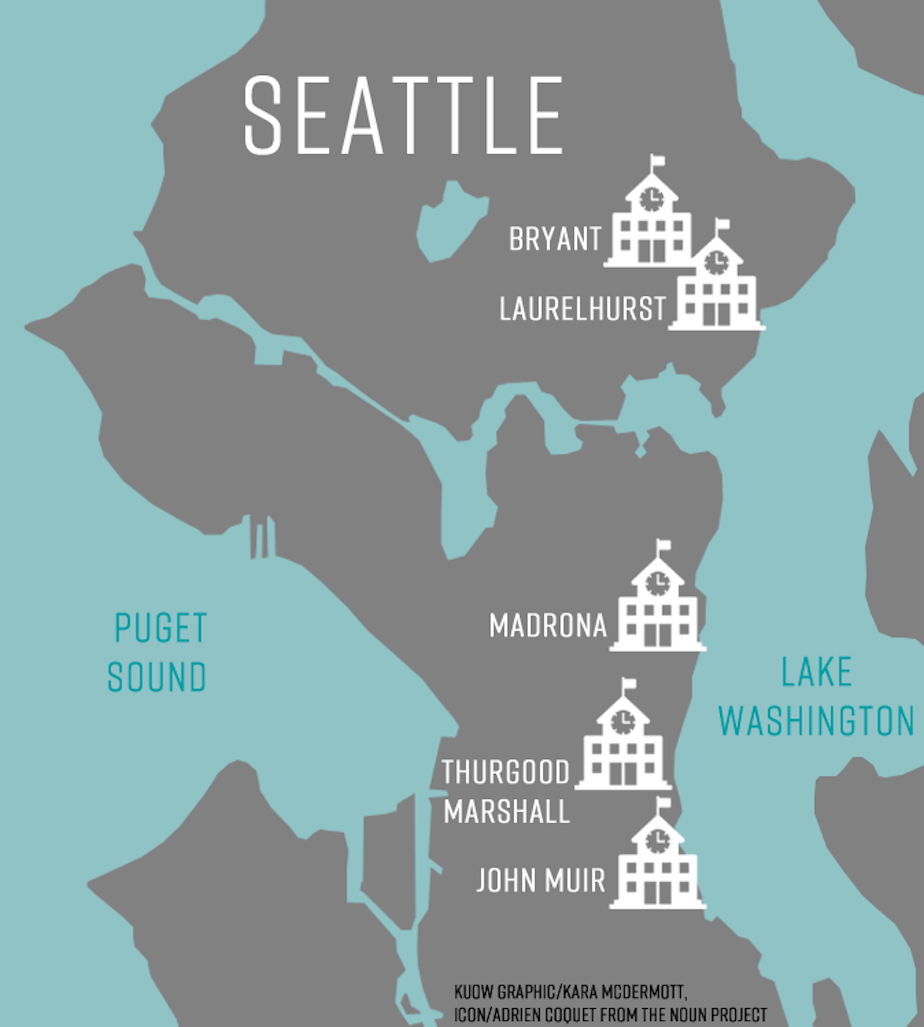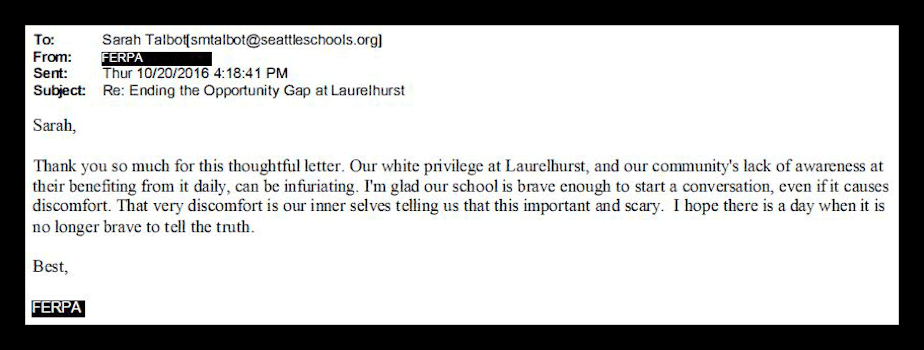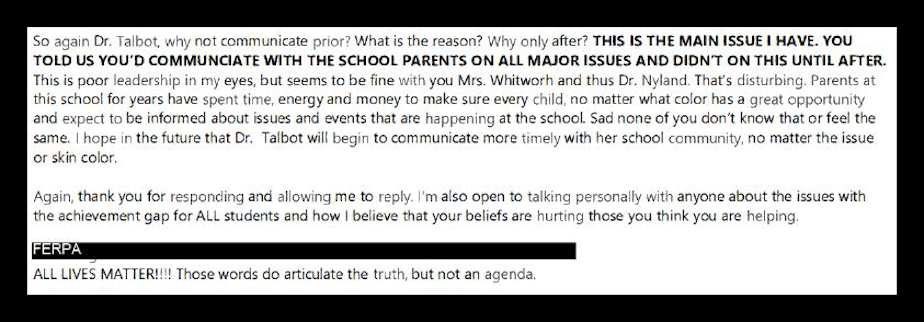To understand white liberal racism, read these private emails
This story was published originally in 2017.
On a gray day in October 2016, teachers across Seattle wore a shirt that read BLACK LIVES MATTER.
They knew there might be criticism. John Muir Elementary in south Seattle had done this in September and received a bomb threat and hate mail from across the U.S.
But they did, and the day was, by most accounts, uneventful. Some kids got it – most didn’t. Just another school day.
And then, a backlash, but this time not from outsiders. White parents from the city’s tonier neighborhoods wrote to their principals to say they were displeased. A Black Lives Matter day was too militant, too political and too confusing for their young kids, they said.
Some danced around their discomfort, others snarked in ALL CAPS. These parents would not talk to us, so we made a public records request for their emails.
Their names were blacked out, which is why they are not named here.
Wrote a parent at Laurelhurst Elementary: “Can you please address … why skin color is so important? I remember a guy that had a dream. Do you remember that too? I doubt it. Please show me the content of your character if you do.”
From Eckstein Middle School in Wedgwood: “What about red and black or yellow and white and black? How does supporting Black Lives Matter help that gap?”
And from Bryant Elementary in Ravenna: “I’m writing to share what my 9-year-old daughter told me about what she learned in class regarding the Black Lives Matter discussion. She said she ‘felt bad about being white.’ And that ‘police lie and do bad things.’”

These three schools are in northeast Seattle, one of the whitest, most affluent corners of the city. They are also in staunchly liberal neighborhoods dotted with rainbow yard signs that say “All are welcome.”
“This is what I’ve come to call Seattle’s passive progressiveness,” said Stephan Blanford, a Seattle school board member whose doctoral research focused on race and public education. “We vote the right way on issues. We believe the right way. But the second you challenge their privilege, you see the response.”

Blanford is black and represents the Central District, the historic African-American heart of the city. He wasn’t surprised by the emails from parents after the Black Lives Matter day. Middle-class white parents have asked him for help getting their kids out of Madrona Elementary, which is 44 percent black.
“No one will say to me, ‘We don’t want our kids to go to a black school,’ but I believe that’s frequently the underlying reason,” Blanford said.
Black Lives Matter emerged from a Twitter hashtag in 2013. The movement gained momentum as videos emerged of police officers killing black men, and from there became a rallying cry against racism. Those three words say that black lives haven’t mattered enough in this country, and that they should.
Reaction to the Black Lives Matter day might have been more muted had Sarah Talbot, the principal at Laurelhurst, not sent an email afterward to parents.
“I heard from a few parents concerned about what teachers weren’t saying,” Talbot wrote.
“They weren’t saying anything about lives — the lives of students, parents and families — who are not black. I worried about that too.
"Would our Native students feel left out, since they face the same (or worse) effects of systemic racism in schools and outside of schools that black students face? What about the majority of the students in our school who are white? They also live with the effects of a society that unfairly prioritizes their lives.
“But then I remembered that at Laurelhurst Elementary, we have a 20 percent difference in the growth of black students’ reading skills when compared to the average growth of all students at our school."
The Laurelhurst Blog, which doesn't name its writer, wrote to media a week later: “Many parents contacted the Laurelhurst Blog and found the email disturbing, divisive and offensive, and one called it ‘racially biased.’"
According to the blogger's email, parents also said: “Talbot says there is ‘injustice’ and there are ‘gaps’ – but where are her examples? Since she didn’t provide any, is it her own invented bias that she is bringing to the community, creating divisiveness?”
Director Blanford urged me to interview Jill Geary, the school board director representing northeast Seattle. Geary is a white mom of five with a daughter at Laurelhurst Elementary; maybe she could explain parent thinking there, he said.
Geary doesn’t see herself as a total insider, however. She was once an administrative law judge who focused on special education; years ago she refused to join other parents in trying to oust a program for highly traumatized kids at Laurelhurst.
She sighed a little as she explained:
“They would prefer to be ‘all lives matter,’ because then their child is included in the conversation about mattering,” she said. “What they don’t think is, would a black mother feel like her child matters, based upon the way that history, the nation, the city, the institutional structures, have treated her child? That’s not the process they’re using.”


I asked Jennifer Harvey, a religion professor in Des Moines, Iowa, to read these emails and share her thoughts. Harvey recently had an opinion piece in The New York Times titled, “Are we raising racists?”
“As a white person myself, I hear and I know how white people think about race, and I wasn't surprised to see just a basic lack of understanding of how racism functions,” Harvey said. “This would not be unique to Seattle liberal whites, nor among liberals who didn't vote for Trump. These kind of sentiments are very deep seated.”


She continued: “What I see when I read these emails is this utter failure to value black life. Because if you value black life you go, ‘Oh my god, even if I don't understand this, why is it that African-Americans need to have this movement for black lives, and what is it like to be a 10-year-old child who's black?
“It's like there's this total white vortex that just screams out from these emails, whether they are being nasty intentionally or just saying, 'I don't get it.' They make me really sad.”
Correction 6/20/2017: An earlier version of this story may have left the incorrect impression that the second quote attributed to the Laurelhurst Blog was posted to the blog itself. In fact, the quote was included as part of the email the Laurelhurst Blog sent to media outlets, including KUOW.

